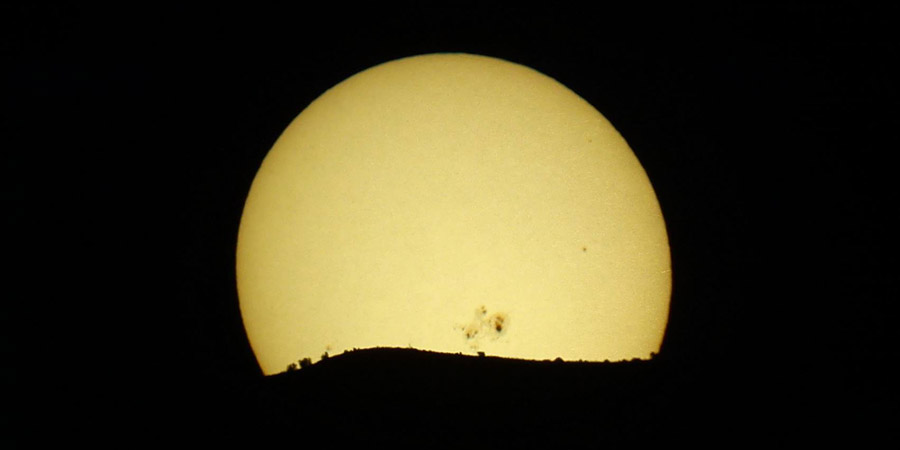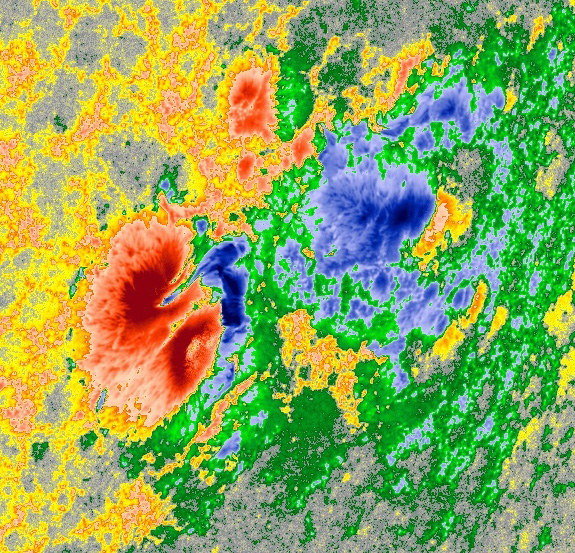Evolution of sunspot region 2192
Sunday, 26 October 2014 21:32 UTC

Solar activity is at high levels. We already saw an X2 solar flare today from sunspot region 2192 but this sunspot region continues to be active and is now firing M-class solar flares on a regular basis. The X2 solar flare from today unfortunately did not release a coronal mass ejection. In this article we take a look how sunspot region 2192 is developing. Our header image was taken by Sajad Sayadi on October 23, 2014 at Fasa/Fars/Iran. He captured this picture of our nearest star at sunset with a great view of sunspot region 2192. He captured this shot from the Observatory & Scietific Center of Fasa (OSCF) in south Iran with a 14 inch telescope. Stunning work!
Evolution of sunspot region 2192
Sunspot region 2192 was relatively stable since our last update but did loose some penumbral area in it's intermediate layout. However, there remains a strong delta structure near the large trailer spot that even seems to try to penetrate the large trailer spot. This likely causes the high X-ray flux that we are seeing right now and we can conclude that sunspot region 2912 remains magnetically complex enough for more strong solar flares. We are slightly raising the chances for strong solar flares because of the development in the trailing delta structure which is tightly packed and likely to give more fireworks. The risk for more M-class (R1+R2) solar flares in the next 24 hours is very high and an X-class (R3) event also remains possible. We do need to note that sunspot region 2192 is now slowly rotating away from Earth and any eruptions will be less likely to hit Earth as time passes. A strong eruption from sunspot region 2192 could also cause a solar radiation storm which would impact HF radio communications at arctic latitudes.


All the other sunspot regions on the disk are unremarkable. Any future solar flares will very likely be centered around sunspot region 2192.
Solar flare odds for the coming 24 hours
M-class flare probability: 90% chance
X-class flare probability: 30% chance
Images: NASA SDO and Sajad Sayadi.
Thank you for reading this article! Did you have any trouble with the technical terms used in this article? Our help section is the place to be where you can find in-depth articles, a FAQ and a list with common abbreviations. Still puzzled? Just post on our forum where we will help you the best we can!
Latest news
Latest forum messages
Support SpaceWeatherLive.com!
A lot of people come to SpaceWeatherLive to follow the Sun's activity or if there is aurora to be seen, but with more traffic comes higher server costs. Consider a donation if you enjoy SpaceWeatherLive so we can keep the website online!

Space weather facts
| Last X-flare | 2025/03/28 | X1.1 |
| Last M-flare | 2025/04/18 | M4.4 |
| Last geomagnetic storm | 2025/04/16 | Kp8- (G4) |
| Spotless days | |
|---|---|
| Last spotless day | 2022/06/08 |
| Monthly mean Sunspot Number | |
|---|---|
| March 2025 | 134.2 -20.4 |
| April 2025 | 120.1 -14.1 |
| Last 30 days | 116.4 -25.9 |


